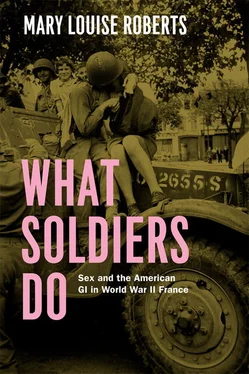Nothing indeed and that became the problem: the myth of the manly GI turned out to be too successful. Sexual fantasies about France did indeed motivate the GI to get off the boat and fight. But such fantasies also unleashed a veritable tsunami of male lust. The GIs were known for their promiscuity in all theaters, whether European, Mediterranean, or Pacific. Still the case of Le Havre appears exceptionally bad, with the GIs having sex anywhere and everywhere in broad daylight in full public view. Brothels, parks, bombed-out buildings, cemeteries, railway tracks—all became landscapes for sex in French cities. Paris, in particular, became a celestial city of total erotic satisfaction, though not without ill effects among the soldiers, who suffered soaring rates of venereal disease.
In struggling to control the unruly effects of the fantasies they had created, military authorities learned to become Siegfried’s “giants.” The military management of sexual behavior served to delineate and consolidate US authority in northern France. As it did in other theaters of war, the military downplayed the role of GIs in spreading venereal infection. Shifting to women the primary responsibility for sexually transmitted disease had the tonic effect of avoiding accountability for both its expense and suffering. Blaming the French also justified regulation of the mobility and health of civilian populations. The army felt justified in declaring all French women objects of American control, thus depriving the French government of its prerogative to manage its own population. As in Le Havre, the army everywhere insisted on keeping French sexual labor invisible to the US public back home. Social disruption and venereal disease were the results.
Rape posed an even greater threat to the myth of the American mission as sexual romance. In the summer of 1944, Norman women launched a wave of rape accusations against American soldiers, threatening to destroy the erotic fantasy at the heart of the operation. The specter of rape transformed the GI from rescuer-warrior to violent intruder. Forced to confront the sexual excesses incited by its own propaganda, the army responded not by admitting the full range of the problem, but by scapegoating African American soldiers as the primary perpetrators of the rapes. Within the year, twenty-five black soldiers had been summarily tried and executed on French soil, hanged by rope. Cooperation between the US military and French civilians account for the proliferation of rape convictions against black soldiers. Both sides shared a deadly set of racist attitudes and a fear that they were losing power. For the US military, the raped woman undermined its control over its mission in Europe. For civilians, she symbolized the loss of control over their own country.
Sex was fundamental to how the US military framed, fought, and won the war in Europe. Far from being a marginal release from the pressures of combat, sexual behavior stood at the center of the story in the form of myth, symbol, and model of power. By contending that sex mattered, this book presents GI sexual conduct as neither innocent of power nor unimportant in effect. Too often in the past, such promiscuity has been dismissed as “boys-will-be-boys” behavior, a mere sideshow of the war fueled by the extraordinary needs of men in battle. Military historians have largely ignored the sexual habits of American soldiers, considering it a historically inconsequential matter. The historian Stephen Ambrose, for example, makes only passing reference to “girls” in his popular histories. 20By contrast, this book brings sex to the center of the story and demonstrates its profoundly political character at this moment. Historians have amply demonstrated that sexual contact between GIs and women shaped American foreign policy and the “Americanization” of defeated Japan and Germany. 21This book builds on such work by demonstrating that postwar transnational relations, far from being confined to diplomatic or political circles, were shaped at every level of society, and often emerged through specific cultures of gender and sexuality. Weed’s refusal to deal with prostitution in Le Havre says a lot about his sense of privilege at that particular moment. As for Voisin, he had no response for Weed. That kind of American arrogance—and the French humiliation it produced—profoundly shaped relations between the two nations.
1
Soldier, Liberator, Tourist
In the wee hours of 6 June 1944, Angèle Levrault, a sixty-year-old schoolmistress from Sainte-Mère-Église, awoke with a start. She rose from her bed and exited the back door to use her outhouse. She heard odd fluttering sounds. What she found in her backyard was stranger still: a man with a face streaked in war paint had landed in her garden and was trying to cut himself free from a parachute. Madame Levrault stood frozen in her nightgown. The man’s eyes met hers. He raised his finger to his lips, signaling her to be silent, and then slipped away into the night. Although she did not know it at the time, Madame Levrault had just met Private Robert M. Murphy of the Eighty-Second Airborne Division, one of the first Americans to land in France on D-day. 1A few hours after their encounter in the garden, thousands of Murphy’s countrymen would take their first step onto French land at Omaha and Utah Beach. Thousands of others would take their last step on that sand, if they took a step at all. Before the end of that day, 2,499 Americans would perish on the beaches of Normandy. 2They would reach the shores of France but die before they met even a single French person. Still others, of course, survived the beaches and fought their way across the north of France. Those soldiers are the subject of this book.
For good reason, the Normandy landings have become a sacred event in the American imagination. Historians, politicians, and film-makers have celebrated the campaign as a great moment in the history of the Second World War. There is no doubt they are right. But the story, at least as it has been told by American historians, suffers by focusing too narrowly on military strategy. As the new military history has demonstrated, wars cannot be separated from the values and preoccupations of those peoples fighting them. 3It is also crucial, then, to widen our analytic lens in order to consider the encounter between the American soldier and the French civilian. That relationship began at dawn on the sixth of June in places like Angèle Levrault’s garden; it ended in Le Havre some two years later when the last GI got on a boat home.
Because historical narratives focus almost exclusively on the day-to-day heroics of the American GI, they slight the French and leave half the story untold. French civilians appear only at the peripheries of the scene, their roles reduced to inert bystanders or joyous celebrants of liberation. In short, they form nothing more than a landscape against which the Allies fight for freedom. Stephen Ambrose’s very popular histories of the Normandy campaign typify this marginalization of the French. In Citizen Soldiers , a history of the army from Normandy to the Battle of the Bulge, Ambrose mentions the Normans only once, implying that they were collaborationists: “[The landings] came as a shock to the Normans, who had quite accommodated themselves to the German occupation.” 4In Ambrose’s three histories of the campaign, he recounts only one incident in which the Normans help the Allies, and several in which they betray the GIs. 5Otherwise, they appear to be children eager to kiss the Americans’ hands, delighted at their liberation, but largely passive and mute. 6In sum, Ambrose reproduces what he sees as the general GI view of French civilians—as “ungrateful, sullen, lazy and dirty.” 7
Читать дальше












